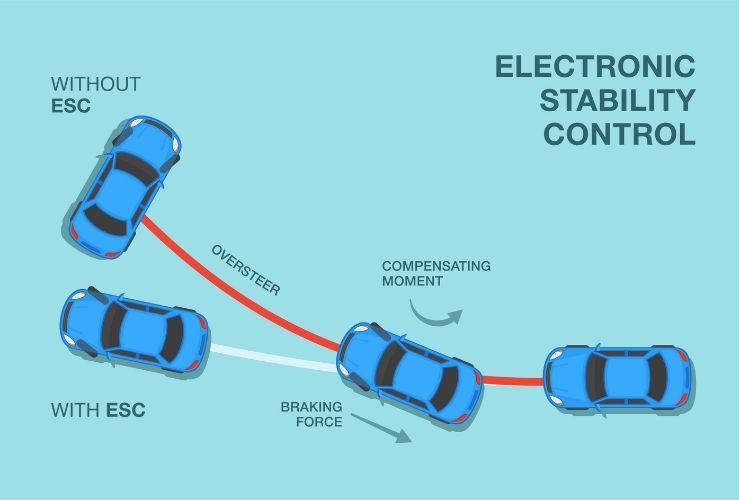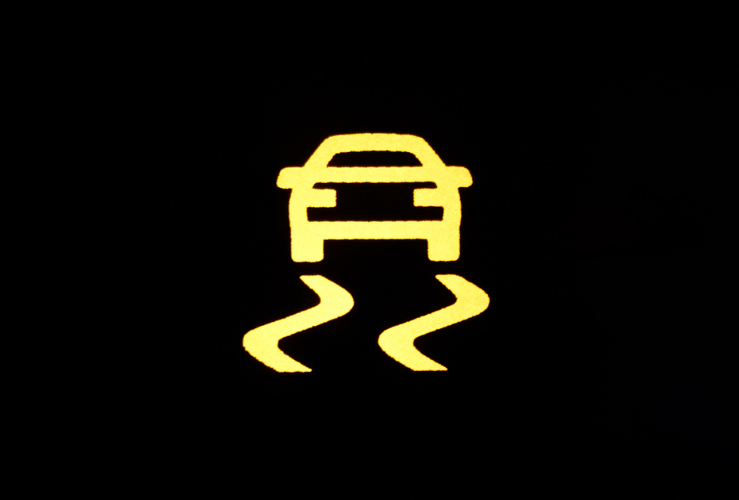How does electronic stability control (ESC) prevent collisions?
You may have seen it listed on your car’s safety specifications without knowing what it does. So, what is ESC?
ESC Meaning: What is ESC?
In short, electronic stability control (ESC) or dynamic stability control (DSC) is a safety system on modern cars that prevents loss of control when maneuvering and helps to prevent accidents.

Electronic Stability Control (ESC) key points
- ESC helps prevent collisions by improving steering control
- ESC helps the driver stay on their intended path
- ESC can assist when road conditions are wet, snowy or icy
- Vehicles fitted with ESC are 25% less likely to be involved in a fatal collision, compared to those without it
- ESC can reduce collisions related to skidding or overturning by 59%
- However, ESC is not a substitute for careful driving; it won’t be able to assist if a vehicle is travelling too fast - for example, while taking a corner
- ESC is not designed to prevent rollover (see rollover stability control, RSC, below), although it may be of benefit

ESC System sensors
An ESC system consists of sensors that continuously monitor for a loss in traction
- Steering wheel angle sensor - Determines where the driver wants to steer.
- Yaw rate sensor- Measures the rotation rate of the car.
- Lateral acceleration sensor (accelerometer)
- Wheel speed sensors
How does Electronic Stability Control work?
The ESC system is activated if sensors detect the car is not responding as the driver intends, particularly when a corner is taken too fast or if a sudden evasive manoeuvre is necessary.
ESC builds on the anti-lock braking system which helps a driver maintain optimum braking effort and full steering in an emergency situation, with a view to preventing or minimising skidding.
Where ABS only activates when you apply the brake pedal, if ESC system sensors detect a loss of steering wheel control or traction, ESC will engage to try and retain control of the vehicle.
ESC and sliding / skidding
Electronic stability control detects if the car is going into a slide or a skid, and applies necessary braking pressure on the wheels, asymmetrically.
ESC and cornering / travelling on wet or icy surfaces
When cornering, or travelling over wet or icy surfaces, a vehicle rotates around the vertical axis. If this rotation is excessive, or insufficient, the ESC system will activate.
Sensors continually monitor how well the vehicle is carrying out the driver's orders, comparing steering inputs with the speed of each wheel, and the car’s rotation.
ESC: How does it work upon activation?
When ESC is activated, different degrees of pressure may be applied to different wheels. For example, breaking the outer front wheel to counter oversteer, or the inner rear wheel to counter understeer.
Some variants of ESC also reduce engine power until the vehicle regains control.
ESC cars essentially help the vehicle steer where the driver intends.
The whole process takes a few milliseconds. It works to prevent loss of control much quicker than a human driver is able to.

Do ESC systems improve cornering performance?
No. ESC works by preventing the driver from losing control on the road. It does not make the vehicle better at cornering.
Do all vehicles have ESC?
No. However, in the UK all new cars have been fitted with ESC since 2014 by law.
While other safety systems like airbags and seatbelts help prevent or reduce injuries in the event of a crash, ESC actually helps prevent a crash from occurring in the first place.
Car makers have different names for ESC
When looking for "electronic stability control" on a new car's specifications, it may appear as one of the following alternative names (among others).
- ESP Electronic Stability Programme
- ESC Electronic Stability Control
- ASC Active Stability Control
- ASC Automatic Stability Control
- VDC Vehicle Dynamic Control
- DSC Dynamic Stability Control
- DSTC Dynamic Stability and Traction Control
- VSA Vehicle Stability Assist
- EVSC Electronic Vehicle Stability Control
History of the electronic stability program
The history of the electronic stability program and ESC cars can be traced back to 1983, when Toyota introduced a four-wheel electronic "Anti-Skid Control" system on its Crown model.
This was followed by traction control systems in 1987, introduced by Mercedes-Benz, BMW and Toyota. In 1990, Mitsubishi launched its active trace & traction control system (called TCL), debuting on its Diamante model.
The safety technologies of ESC were further developed throughout the 1990s, with new ESC systems from Mercedes Benz, Toyota, GM, Audi and others.
Canada was one of the first to make ESC mandatory on all new cars in 2011, followed by the United States in 2012 and the EU (and therefore the UK) in 2014.

In performance driving, ESC may be considered a hindrance, since it prevents actions like drifting. As a result, in most cars the system can be overridden if desired. However, in everyday use, it is a proven safety feature and should not be turned off.
Can ESC work on any surface?
Electronic stability control functions on a wide variety of surfaces, from ice-covered roads to frozen lakes.
ESC can also work in off-road situations, but effectiveness can vary because of the vast number of different forces acting on the vehicle, and how the system was programmed by the manufacturer in the first instance.
Data on ESC safety
According to data from America's National Highway and Traffic Safety Administration in 2004, ESC reduced collisions by 35%. It also found that SUVs with ESC were involved 67% fewer accidents compared to SUVs without it.
2006 research by the United States Insurance Institute for Highway Safety (IIHS) concluded that 10,000 fatal crashes each year could be avoided if ESC was installed on every vehicle.
In the UK, data from 2007 suggested vehicles with ESC were 25% less likely to be involved in a collision than those without it, equating to around 380 fewer fatalities annually.
ESC faults
Despite its effectiveness, ESC systems can malfunction.
Some of the most common problems that can cause an ESC system to not work correctly include:
- Faulty sensors, such as wheel speed sensors
- Failed components
- Faulty wiring
- Software issues
- Damaged control modules.

ESC Light on: What does it mean if my ESC Light is on?
The ESC light should only be on when you start the car for a couple of seconds and then turn it off.
If the ESC light flashes on when driving, it means that the system is engaged and trying to keep the vehicle under control.
If you find that your ESC light remains on, this could be due to various reasons.
ESC Light on permanently
If your ESC light remains on all the time, firstly check to see that you haven’t accidently turned off the ESC system.
Most vehicles with a button to turn on the stability control also have “off” written underneath the symbol.
If your ESC light is on and your vehicle does not have an ESC button, or you have replaced the car battery, try restating the engine, and turn the steering wheel fully left and right several times. Then drive for a minute, and this may reset the ABS and ESC lights.
If your ESC light remains on after restarting your car engine, you should get it checked at a garage as the electronic stability control system is an important safety feature.
The garage will use a diagnostic scanner to determine why your stability control light is on.
What is ESC’s future?
In the same way ESC was built on the development of anti-lock braking (ABS), Roll Stability Control (RSC) is being developed on top of ESC. RSC operates on a vertical plane just as ESC works on a horizontal plane.
In order to prevent a roll, RSC applies brakes asymmetrically, reducing engine power, understeers, and/or reducing speed.
More motoring advice
Experiencing issues with your car juddering?




